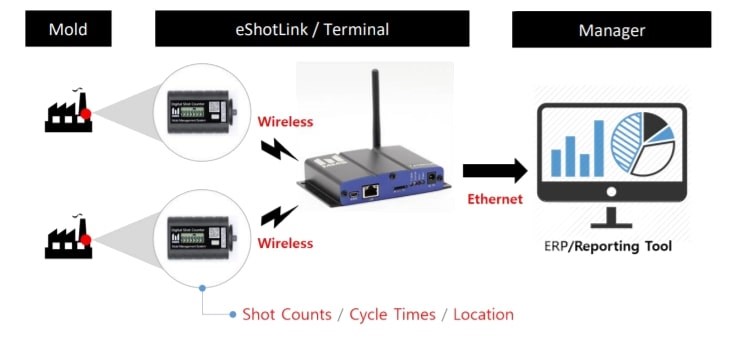Machine Learning for Mold Monitoring 101
Outsourced tooling supply chain management system offers data automation, more in-depth tooling analytics and performance trend measurements.
Many large OEMs continue to struggle with monitoring tooling, such as molds, dies and castings, that they outsource for parts production. Although manufacturing is at the turning point of Industry 4.0, it is hard to believe that most OEMs still rely heavily on supplier spreadsheets for mold data, which severely limits the accurate and timely analysis of parts production and mold usage data transparency.
Within these large OEMs, tooling engineers are the most affected and often feel powerless when it comes to this delayed and incomplete data. Next, the questions begin:
- Is there any inventory that the tooling engineer can use to produce the same part? (This will minimize any possible disruption in downstream assembly)
- How much corrective maintenance has been performed on this mold so far?
- Is it more economical to get a new mold or fix this one?
- Is this tooling within the guarantee period? If so, what’s the process to get the tooling up and running within the guaranteed period? Who is responsible for the breakdown? Is the supplier at fault due to improper operation or the toolmaker for poorly-manufactured tooling?
- Do we have the toolmaker’s performance history and data-driven performance to benchmark among toolmakers? Is this an isolated case or this is similar across OEM’s global supply chain?
- How active are toolmakers in preventing tooling breakdown? Are these relevant data points shared and used to advise suppliers and to prevent costly breakdowns?
- Did the tooling break down because it exceeded the designed maximum cycle counts?
- Do we need to worry about the quality of parts produced beyond the designed maximum cycle counts? Is there a possible quality issue problem?
Tooling engineers, however, are not the only group affected. Procurement (commodity managers) struggles as well because tooling is easily one of an OEM’s (especially those in automotive) largest owned assets. In addition, new tooling expenditures for companies continue to grow despite OEMs trying to reduce supply chain costs. The right tooling supply chain management system should provide outsourced part production costs, data automation, more in-depth tooling analysis, and performance benchmark evaluations of the toolmaker, and much more.
The continual automation of mold data collection—data flow from wireless counters into a database—also yields predictive maintenance capabilities. Machine learning can then use this database to identify the point at which a mold reaches suboptimal conditions and notify tooling engineers of a required PM. This step minimizes unexpected downtime and supply chain disruption, increases mold life and reduces cost per part produced.
A few years ago, one of the world’s largest OEMs started monitoring all of its global tooling with wireless counters and a fully integrated tooling supply chain management system. The counters were mounted with a bracket or placed into a predetermined slot on all of the tooling to gather information (shot count, cycle time, location, etc.).
This data was then relayed back to the tooling supply chain management system. The company is now looking to integrate the data sets into machine learning algorithms to better utilize its tooling supply chain management system, to improve tooling health and lifespan, to decrease the number of faulty parts produced and to allow companies to benchmark its toolmakers’ performance. Applying a tooling supply chain management system along with machining learning and artificial intelligence to manufacturing will soon be the next industry requirement.
Check back on this blog for more posts that explore how machine learning can improve how companies monitor their molds.
For More Information
About the Authors
Myung Jin (Mardi) Park is the head of sales and marketing of eMoldino’s Tooling Supply Chain Management System. Dr. Jongsun Kim is the Principal Researcher of Mold & Dies R&D Group at Korea Institute of Industrial Technology, Gyeonggi-do, Republic of Korea.
Related Content
How to Select a Mold Temperature Controller
White paper shares how cooling channel analysis, which collects maximum pressure drop, total flow rate and heat dissipation, eases the performance evaluation of mold temperature controllers.
Read MoreHow to Manage Wall Thickness Changes in Your Mold Design
To ensure even filling and cooling, consider wall section transitions, corners and fillets, ribs and bosses, lip and rim designs and CAE flow simulation software.
Read MoreWhat is Scientific Maintenance? Part 2
Part two of this three-part series explains specific data that toolrooms must collect, analyze and use to truly advance to a scientific maintenance culture where you can measure real data and drive decisions.
Read MoreHow to Improve Your Current Efficiency Rate
An alternative approach to taking on more EDM-intensive work when technology and personnel investment is not an option.
Read MoreRead Next
Are You a Moldmaker Considering 3D Printing? Consider the 3D Printing Workshop at NPE2024
Presentations will cover 3D printing for mold tooling, material innovation, product development, bridge production and full-scale, high-volume additive manufacturing.
Read MoreHow to Use Strategic Planning Tools, Data to Manage the Human Side of Business
Q&A with Marion Wells, MMT EAB member and founder of Human Asset Management.
Read More











.png;maxWidth=300;quality=90)













